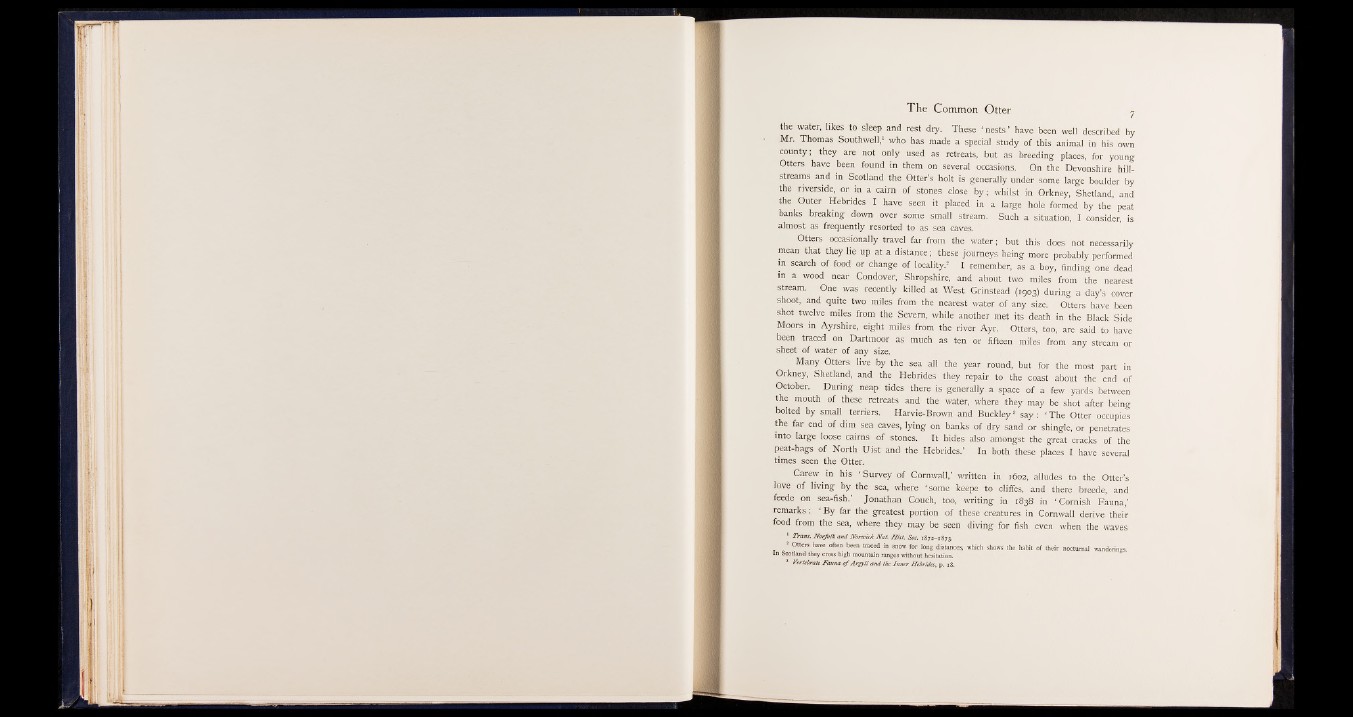
The Common Otter y
the water, likes to sleep and rest dry. These ‘ nests ’ have been well described by
Mr. Thomas Southwell,1 who has made a special study of this animal in his own
county; they are not only used as retreats, but as breeding places, for young
Otters have been found in them on several occasions. On the Devonshire hill-
streams and in Scotland the Otter’s holt is gaaeklly under some large boulder by
the riverside, or in a cairn Sol stones close by ; whilst in Orkney, Shetland, and
the Outer Hebrides I have seen it placed in a large hole formed by the peat
banks breaking down OvBf some; small stream. Such a situation, I consider, is
almost as frequently resorted to as sea caves.
Otters occasionally travel far from the water; but this does not necessarily
mean that they lie up at a distance, these journeys being more |robably performed
in search of food or change g lo c a lii» | X remember, as a boy, finding fine dead
m a wood near Condover, Shropshire, and about two miles from the nearest
stream. :;|>ne was recently killed at West Grinstead (1903) during a day’s, cover
Sho.pt, and quite two foi|(es from the nearest water of any p | ® | p f t e r s hive been
shot tw e * miles from the Severn, while another met its death in the;' Black S id lj
Moors in Ayrshire, .eight miles from the river Ayr. Otters,/too, are said to have
been traced on Dartmoor as much as ten or fifteen miles from any, stream or
sheet of water of any size.
Many Otters live by the sea all the year round, but for the rdost part in
Orkney, Shetland, and the Hebrides tidy repair to the coast about the end of
October. During neap tides there is geneMly a space of a few yards between
the mouth of these retreats and the water, where they may l l ’^shot after being
bolted by small terriers. Harvie-Brown and Buckley I s a y : ’ The Otter occupies
the far end of dim sea caves, lying phi banks of dry sand or shingle, or penetrates
into large loose cairns of stone|| It hides also amongst the great cracks of the
peat-hags of North,-tlist and the H ^ id e s .’ In both these places I have several
times seen the Otter.
Carew in his ‘ Survey of Cornwall,’ written in 1602, alludes to the Otter’s
love of living by the sea, where ‘ some keepe to cliffes, and there breede, and
feede on sea-fish.’ Jonathan Couch, too, writing in 1838 in ‘ Cornish Fauna,’
remarks: ‘ By far the greatest portion of these creatures in Cornwall derive their
food from the sea, where they may be seen diving for fish even when the waves
1 Trans. Norfolk and Norwich Nat. Hist. Soc. 1872-1873.
2 0tters have Gften been traced in snow f°r long distances, which shows the habit of their nocturnal wanderings.
In Scotland they cross high mountain ranges without hesitation.
3 Vertebrate Fauna o f Argyll and the Inner Hebrides, p. 18.